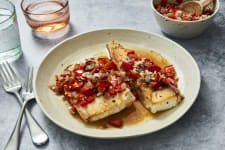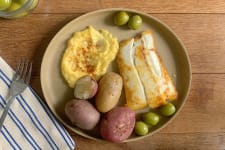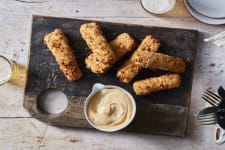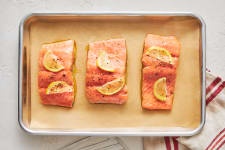Grilling seafood is an absolute joy. However, if you’re unsure how to cook seafood on the grill, you can end up with a fish fillet charred in the flames. With a few tips and tricks, you can keep grilled seafood moist, flavorful, and out of the fire.
Why Seafood Is Great on the Grill
Grilling is an excellent option for cooking your fish quickly. It also imparts a dramatic flavor that’s near impossible to replicate; when the flame of a gas or charcoal grill touches wild-caught seafood, the taste transforms into a savory, smoky bite. Plus, grill marks on salmon or a hearty white fish are the hallmark of a backyard feast and the special time of year you get to spend time outdoors, connecting with nature.
Of course, if you don’t have an outdoor grill or simply love grilled seafood beyond spring and summer, you can grill anytime with a cast-iron grill pan. Whether you’re cooking fillets, skewers, or salmon burgers, the pan’s high heat will impart beautiful grill marks and give your dishes the same smoky flavor as outdoor grilling.
Tips for Grilling Fish
Seafood is a delicate protein, so introducing it to high heat, while delicious, can be tricky.
-
Start with a clean grill. After the grates have heated, use a grill brush or half an onion to remove any gristle.
-
Use a barrier. Fish skin, a tool like a cedar plank, or even a marinade or spice rub can act as a barrier between the heat and the fish. The fish will take on the heat first, infusing the flavor of the marinade, the plank, or the spice rub into your wild seafood, helping to keep the fish moist.
-
Consider grilling equipment. The right tools can prevent your fish from sticking to the grill. You can use gadgets like grill baskets, wooden skewers, and metal skewers to keep your fish on top of the grates and out of the flames. Some of the best grilled seafood recipes use skewers.
How to Grill Seafood Basics
Gather your materials: Your seafood, tea towel or paper towels, fish spatula, high-heat cooking oil, salt and pepper, grill or cast-iron grill pan, and skewers.
Preheat a charcoal or gas grill on high. Meanwhile, use paper towels or a clean kitchen towel to pat excess moisture from seafood—season both sides with salt and pepper.
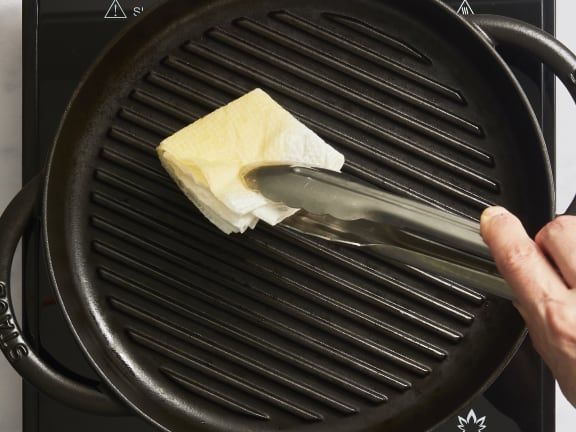
When the grill is hot, lightly oil the grates using tongs and a paper towel.

Place the fish or shellfish on the grill. If you're cooking skin-on fillets, start with the skin-side down. Grill the seafood undisturbed until it flips without any resistance, about 3 minutes.

For fish, cook for an additional 1 to 3 minutes, depending on the portion’s thickness and the species’ fat content. For shellfish, grill until it’s barely opaque through the center.

Several species of white fish are medium-done when their internal temperature reaches 130F at the thickest part on an instant-read thermometer or when flaked easily with a fork. Wild salmon is medium rare when the internal temperature reaches 120-125F.
The optimal internal temperature varies for each species, so double check you’re cooking your fish correctly. Consuming raw or undercooked meats, poultry, seafood, shellfish, or eggs may increase your risk of foodborne illness, especially if you have a specific medical condition. The FDA recommends an internal temperature of 145°F for cooked fish.
Best Types of Seafood for Grilling
Knowing which types of fish go best on the grill can help you enjoy a succesful cookout.
Wild Caught Salmon
Robust wild-caught sockeye salmon is one of the best fish to grill as it will hold its shape. It’s adaptable to many grilling methods—you can grill wild salmon skin-side down on the grates, a cedar plank, or a piece of tin foil.
Grilled salmon is perfect with salad, as a main course with grilled vegetables, and alongside a carb like pasta or rice. Rich, satisfying sockeye salmon burgers that use ground salmon are also an excellent option for a cookout.
Pacific Halibut
Pacific Halibut has a hearty texture and a soft white hue that takes on grill marks beautifully. The halibut’s meatiness and mildness holds up to flavorful sauces and marinades, making it a perfect choice for your favorite barbecue sauces. When you grill wild halibut, be sure to prep the fish by patting it dry to remove excess moisture from the surface of this fish. This will help it brown and crisp up evenly.
Grilled halibut make an amazing base for a hearty sandwich, and it’s delicious as a steak with chimichurri. Bonus: you can use your garden herbs in this refreshing sauce.
Alaskan Shrimp
Many varieties of Alaskan shrimp, such as spot prawns and sidestriped shrimp, have a subtle sweetness that pairs well with smoky grill flavor. They also take on sauces well and can be used in tacos, kebabs, or salads. If you like, you can peel the shrimp before you grill (this is the easiest way to peel spot prawns). Then, load up a skewer with the peeled shrimp to keep them from overcooking and falling into the grill.
The WAC recipe team featured these grilling tips in a live event! Watch the recording of the cooking demo to see how it's made.

